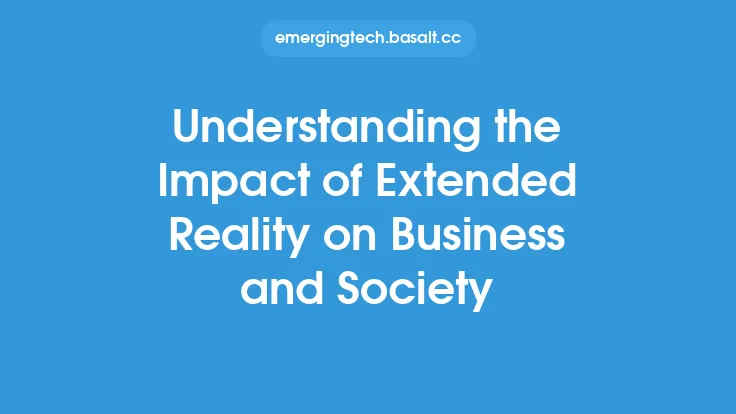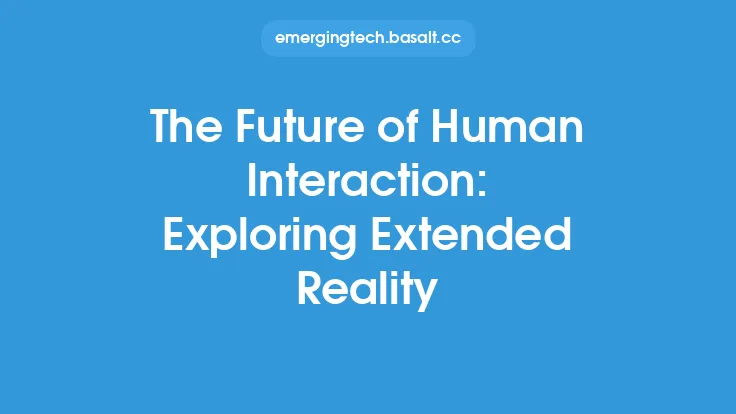The concept of reality has always been a subject of fascination and debate among philosophers, scientists, and technologists. With the advent of Extended Reality (XR), the boundaries between reality and fantasy are becoming increasingly blurred. XR is an umbrella term that encompasses a range of technologies, including Virtual Reality (VR), Augmented Reality (AR), and Mixed Reality (MR), which are redefining the way we interact with and perceive the world around us.
Introduction to Extended Reality
Extended Reality is a term used to describe the combination of virtual, augmented, and mixed reality technologies that are changing the way we experience and interact with the world. XR technologies use a combination of hardware and software to create immersive and interactive experiences that simulate or enhance the real world. These technologies have the potential to revolutionize a wide range of industries, from entertainment and education to healthcare and manufacturing.
Technical Overview of Extended Reality
From a technical perspective, XR technologies rely on a range of components, including displays, sensors, and software. VR technologies, for example, use head-mounted displays (HMDs) to create a fully immersive experience, while AR technologies use see-through displays or mobile devices to overlay digital information onto the real world. MR technologies, on the other hand, use a combination of VR and AR technologies to create a hybrid experience that blends the physical and digital worlds. The technical requirements for XR technologies are significant, requiring high-performance computing, advanced graphics processing, and sophisticated software algorithms to create seamless and interactive experiences.
Applications of Extended Reality
The applications of XR technologies are diverse and widespread, with potential uses in a wide range of industries. In the field of education, for example, XR technologies can be used to create interactive and immersive learning experiences that simulate real-world environments and scenarios. In the field of healthcare, XR technologies can be used to create personalized and interactive treatment plans, as well as to simulate surgical procedures and medical emergencies. In the field of entertainment, XR technologies can be used to create immersive and interactive experiences, such as virtual concerts and movies, as well as to enhance the gaming experience.
Impact of Extended Reality on Society
The impact of XR technologies on society is likely to be significant, with potential effects on a wide range of areas, including education, healthcare, and the economy. XR technologies have the potential to increase access to education and healthcare, particularly in remote or underserved areas, by providing interactive and immersive experiences that simulate real-world environments and scenarios. XR technologies also have the potential to create new job opportunities and industries, particularly in the fields of software development, hardware manufacturing, and content creation.
Challenges and Limitations of Extended Reality
Despite the potential benefits of XR technologies, there are also a number of challenges and limitations that must be addressed. One of the main challenges is the high cost of XR hardware and software, which can make it inaccessible to many individuals and organizations. Another challenge is the need for high-performance computing and advanced graphics processing, which can be a barrier to widespread adoption. Additionally, there are also concerns about the potential health and safety risks associated with XR technologies, such as eye strain, headaches, and motion sickness.
Future of Extended Reality
The future of XR technologies is likely to be shaped by a number of factors, including advances in hardware and software, changes in consumer behavior, and the development of new applications and use cases. One of the main trends that is likely to shape the future of XR is the increasing use of cloud computing and 5G networks, which will enable faster and more seamless experiences. Another trend is the development of new XR devices, such as standalone headsets and smart glasses, which will make XR technologies more accessible and convenient to use.
Conclusion
In conclusion, Extended Reality is a rapidly evolving field that is redefining the boundaries between reality and fantasy. With its potential to create immersive and interactive experiences, XR technologies have the potential to revolutionize a wide range of industries, from entertainment and education to healthcare and manufacturing. While there are also challenges and limitations that must be addressed, the future of XR is likely to be shaped by advances in hardware and software, changes in consumer behavior, and the development of new applications and use cases. As XR technologies continue to evolve and improve, we can expect to see new and innovative uses for these technologies, as well as a growing impact on society and the economy.





